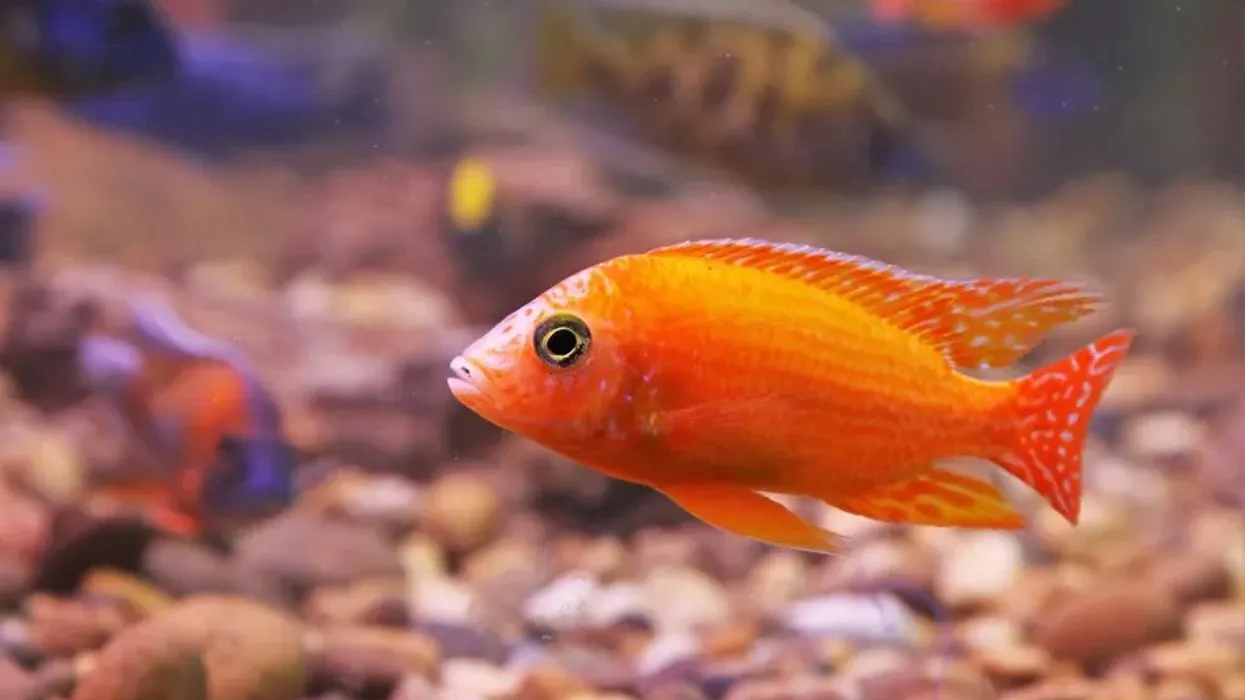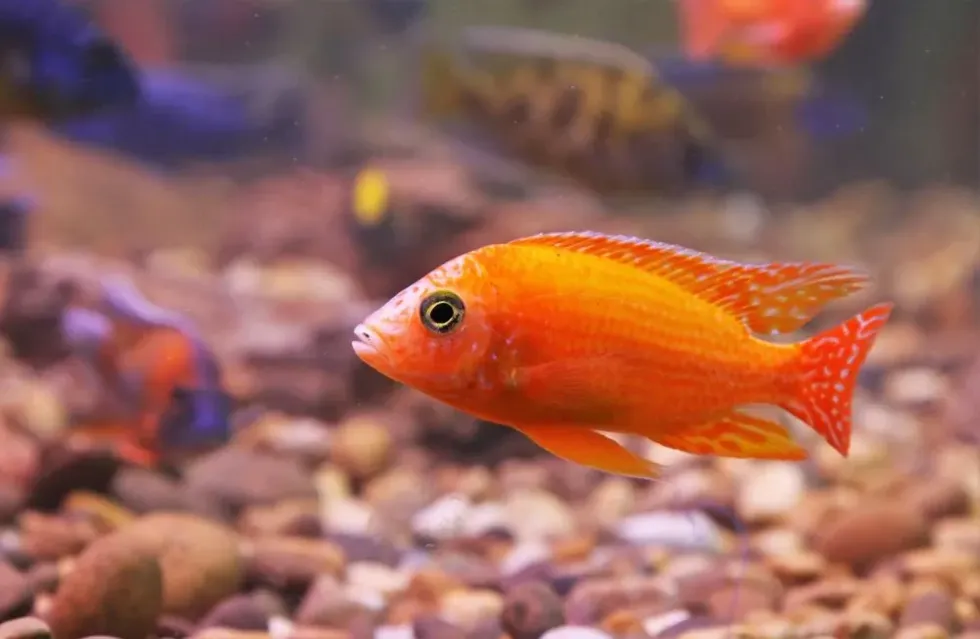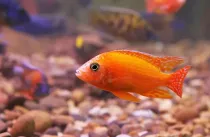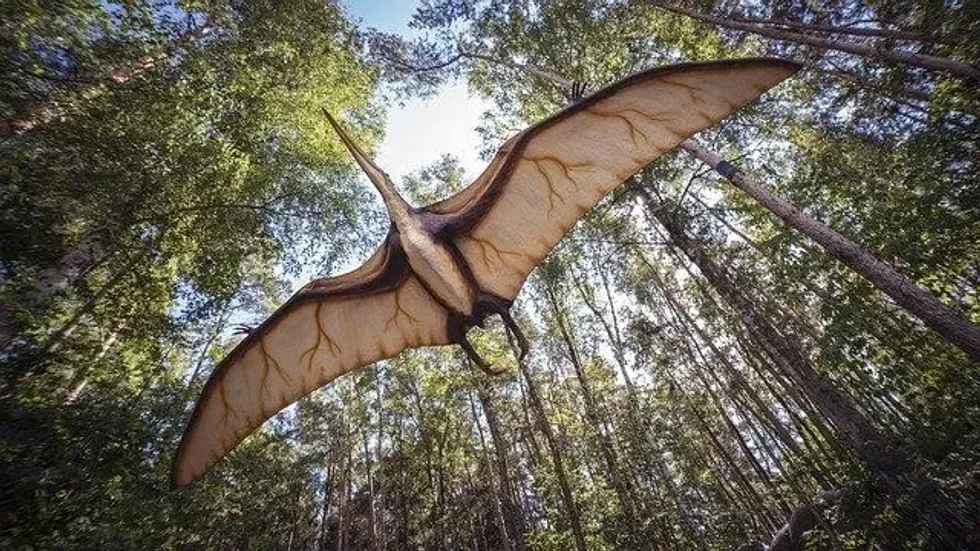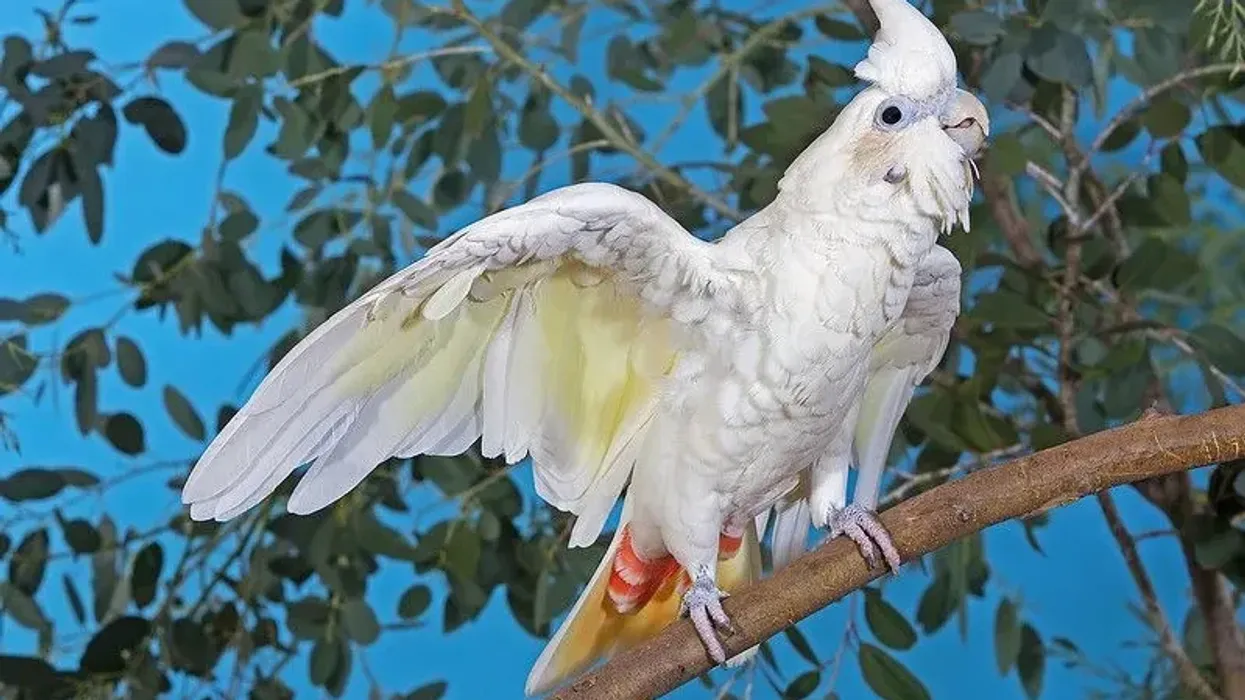Fun Red Zebra Cichlid Facts For Kids

The red zebra cichlid is an attractive cichlid species whose scientific name is Maylandia estherae (previously known as Pseudotropheus estherae). This stunning fish is also known by names such as Esther Grant's zebra, orange zebra cichlid, orange-blue mouth breeder, false zebra Mbuna, orange zebra, red zebra, Mbuna, and Tilapia zebra.
It's a member of the Mbuna group that comprises 13 genera of aggressive and active Mbuna cichlids. 'Mbuna' refers to rock-dwelling and rockfish, describing the environment of these Cichlids.
The false zebra Mbuna is a freshwater tropical fish that is endemic to Africa's Lake Malawi. It can be spotted along the lake's eastern coast from the Chilucha Reef around Metangula towards Narungu.
This cichlid species is a member of the family Cichlidae and the genus Maylandia. It's a very desirable species in the aquarium trade with both the male and the female having an appealing appearance.
This orange-blue mouth breeder is one of the very few Mbuna species that produces botched color mutations. Both sexes look quite different from each other, almost as if they're of different species!
The adult male in the wild is light-blue or pink-colored whereas the female can either be orange-red or brown-beige in color. She also lacks the thick vertical barring that is present in all males.
In captivity, the coloration is different as they exhibit color mutation with the male red zebra cichlid being orange and the female being light orange in color. This stunning fish must be kept in a group with three females for one male in an aquarium.
Are you loving the red zebra cichlid? Keep reading to to know about its habitat, breeding, lifespan, and more!
If you found our red zebra cichlid facts interesting, you must read our seriously cool Rainbow Cichlid fun facts and Firemouth Cichlid facts for kids as well!
Red Zebra Cichlid Interesting Facts
What type of animal is a red zebra cichlid?
The red zebra cichlid is a freshwater fish that belongs to the group Mbuna that comprises many species of cichlids. The red zebras used to be scientifically known as Metriaclima estherae and Pseudotropheus estherae before its current scientific name. They're omnivorous in nature with their diet comprising snails, insect larvae, mites, nymphs, zooplankton, algae, and crustaceans.
What class of animal does a red zebra cichlid belong to?
This species of freshwater fish of Lake Malawibelongs to the class of ray-finned fish, Actinopterygii, like the Nile Tilapia!
How many red zebra cichlids are there in the world?
The population of the false zebra Mbuna is unknown for now due to a lack of research. However, it's estimated that it's abundant in its regions.
Where does a red zebra cichlid live?
This fish is found in tropical freshwater regions. It's endemic to Africa's Lake Malawi's rocky shorelines where it can be spotted along the lake's eastern coast from the Chilucha Reef around Metangula towards Narungu It can be spotted in six regions namely Minos reef, Chilucha reef, Metangula, Nkhungu, Mozambique, and Masinje.
What is a red zebra cichlid's habitat?
This African cichlid can be typically spotted near rocky regions that are sediment-free. It feeds upon Aufwuchs here, which are to the tough stringy algae connected with rocks.
The mineral content is high in the streams of Lake Malawi. Lake Malawi is renowned for its stability and clarity, which is why cichlids are able to inhabit it.
Otherwise, they can deteriorate easily in inadequate water conditions. This cichlid can reside in light brackish water conditions, but not in a tank of full brackish water.
The red zebra cichlid requires a temperature ranging between 73-82 F (22.8-27.8 C) and a ph ranging between 7.6-8.6 in an aquarium. If they're being mixed with a group of other Mbuna cichlids, a 55-gallon (180 l) tank is required. The false zebra Mbuna (common name) requires rock work to occupy and mark as territory.
It's better if the aquarium possesses many passageways with rocks kept in piles. It's a digger by nature, so the rocks must be sitting on the bottom of the aquarium instead of the substrate.
The tank must possess plenty of caves, rocks, and fine gravel substrate. Some hardy plants can be kept for nibbling, but most likely they will be destroyed as this species doesn't do well with plants.
Who do red zebra cichlids live with?
Red zebras aren't a community fish and react well when kept in a group comprising two or three females for one male in a tank. They can inhabit the same tank as other mellow cichlids.
They can reside with Kennyi cichlids (Pseudotropheus kenyi), bluegray Mbuna (Melanochromis iohanni), electric yellow cichlid (Labidochromis caeruleus), bumblebee cichlid (Pseudotropheus crabro) and Pindani (Pseudotropheus socolofi).
How long does a red zebra cichlid live?
When cared for properly, this African cichlid can live as long as 10 years, just like the Midas Cichlid. Red zebras can be affected by Malawi Bloat if their food requirements aren't met.
How do they reproduce?
Red zebras become sexually mature when they reach 3 in (7.6 cm) in length. Male Cichlids will start off by breeding process by displaying to the female, who will lay 20-30 eggs.
She is a mouth breeder and will instantly catch the eggs with her mouth before fertilization. The male then starts flaring his anal fin that possesses an egg spot pattern so as to fool the female to think the egg-like pattern on his anal fin are her eggs.
She ends up stimulating him to release sperm, a milt cloud, which is inhaled by her. This milt cloud fertilizes all the eggs in her mouth.
The eggs hatch after 10 days but surprisingly the fry are kept in her mouth for another 15 days. The eggs develop at a temperature of 82 F (27.8 C). When the fry are released, they're the same color as the females and are guarded by her.
The diet of the young comprises brine shrimp nauplii and finely powdered dry food. These fish are also bred in captivity.
For captive breeding in a tank or an aquarium, one male must be living with 3-5 females in a tank. To condition them to breed properly, they must be fed twice a day.
They prefer slate or flat tone to lay eggs, after successful breeding. Unlike South American cichlids, these fish do not feed their fry.
What is their conservation status?
Red zebras have been classified as Least concern by the IUCN as they do not face any significant threats that can harm their existence substantially. They are, however, affected by diseases, overfishing, and water pollution.
Red Zebra Cichlid Fun Facts
What do red zebra cichlids look like?
Males and females are completely different when it comes to their coloration. This fish is one of the very few Mbuna species that produces botched color mutations.
Both sexes look quite different from each other, almost as if they're of different species! They also have common names that originated due to their spectacular coloration like cherry red zebra and super red zebra. ASdult males in the wild are light-blue or pink-colored whereas females can either be orange-red or brown-beige in color.
Females also lack the thick vertical barring that is present in all males. In captivity, the coloration is different as they exhibit color mutation with the males being orange and the female being light orange in color.
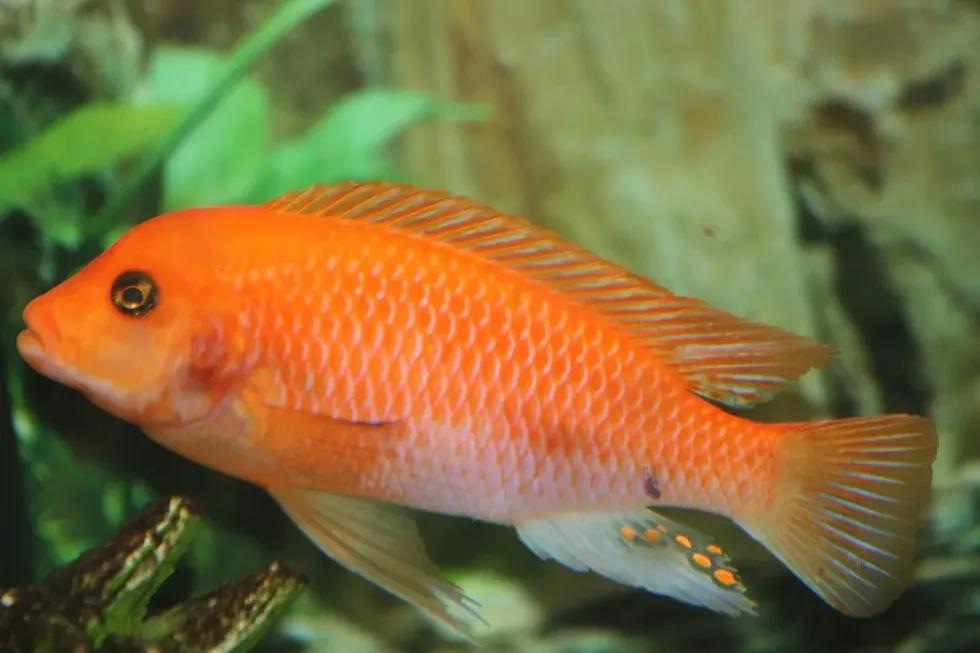
How cute are they?
African cichlids are very cute and extremely desirable to be kept as pets due to their dazzling coloration.
How do they communicate?
These African cichlids can communicate acoustically, chemically as well as visually. Their signals vary from situation to situation.
How big is a red zebra cichlid?
The red zebra cichlid size is quite small compared to other cichlids. It has a muscular form along with a torpedo shape and a broad a sturdily built body.
The length of this spectacular fish varies between the range of 4-5 in (10.1-12.7 cm). It can reach 5 in (12.7 cm) only in an aquarium. It's thrice the size of a golden tetra!
How fast can a red zebra cichlid swim?
As opposed to swift swimming, it can make effortless movements along with precise physical positions due to its soft front fins.
How much does a red zebra cichlid weigh?
The precise weight of the Maylandia estherae (previously known as Metriaclima estherae) has not been evaluated yet.
What are the male and female names of the species?
There is no particular name for males or females of this species of African cichlids.
What would you call a baby red zebra cichlid?
Its baby is called a fry!
What do they eat?
The red zebra cichlid is an omnivorous fish whose diet in the wild mainly comprises aufwuchs like zooplankton and small benthic invertebrates. They eat herbivorous foods when kept in an aquarium and will accept any food to keep their coloration bright. They even eat the algae growing in the tank.
These fish can become overweight easily so they must not be overfed. The red zebra cichlid fry consumes brine shrimp nauplii and finely powdered dry food. They're preyed upon by larger fish.
Are they aggressive?
The red zebra cichlid aggression is a well-known characteristic of these fish. They're quite defensive when it comes to their territory.
Its aggression is considered to be moderate. However, it still can't be kept in a tank with fish that aren't cichlids. They must be given rock caves and plenty of space, with their tankmates being from Lake Malawi as well.
Would they make a good pet?
Red zebra cichlids aren't a community tank species and can only be kept with other cichlid species. It's a great pet only for experienced aquarists as frequent water changes must be made along with adding suitable tank mates.
This freshwater fish is also vulnerable to Malawi bloat if the tank is not appropriate and food requirements are not met. It will consume all foods and breed easily if it's cared for appropriately.
Did you know...
The name of this red zebra cichlid originated from the name of the wife of a cichlid exporter Stuart Grant whose name was Esther.
The keyhole cichlid is one of the least aggressive cichlid species.
How to tell if a red zebra African cichlid is male or female?
Males are larger than females and are light blue-colored with bands that are vertical and dark-colored. Males can also have no bands and be an orange-red color along with the anal fin possessing 4-7 egg spots.
The female on the other hand is orange or yellow and may or may not have dark-colored spots on her body, and possesses 0-3 egg spots.
Having your own red zebra cichlid
Red zebra cichlid care can be quite challenging for beginners, which is why this fish is recommended only for experienced aquarists. They can be acquired for an average price online, and in fish stores as well.
Red zebras have been bred extensively and must be bought from a reputed dealer only. This species is omnivorous and can their diet must comprise foods like pellets, flakes, romaine lettuce, spinach, live foods like crickets, brine shrimp, and worms when kept in a tank.
They also feed upon the algae growing in the aquarium. It reacts well when kept in a group comprising two or three females for one male.
Here at Kidadl, we have carefully created lots of interesting family-friendly animal facts for everyone to discover! For more relatable content, check out these convict cichlid fun facts and peacock cichlid surprising facts!
You can even occupy yourself at home by coloring in one of our free printable betta fish coloring pages!
We Want Your Photos!
More for You
See All
Bachelor of Business Administration specializing in Management

Rhea NischalBachelor of Business Administration specializing in Management
A background in Business Administration and Management from MCM DAV College, Rhea has led her to work for her father's global business. However, her passion for content production, where she manages operations to ensure all processes run smoothly. Outside of work, she enjoys playing the piano and spending time with her one-year-old nephew.
Bachelor of Arts specializing in Economics

Gowri RaoBachelor of Arts specializing in Economics
With a bachelor's degree in Economics from Krea University, Gowri is a highly skilled data analyst and an expert in regression and causation modeling. Her interests in economic trends, finance, and investment research complement her professional expertise. In addition to her professional pursuits, Gowri enjoys swimming, running, and playing the drums, and she is also a talented tutor.
Disclaimer
1) Kidadl is independent and to make our service free to you the reader we are supported by advertising. We hope you love our recommendations for products and services! What we suggest is selected independently by the Kidadl team. If you purchase using the Buy Now button we may earn a small commission. This does not influence our choices. Prices are correct and items are available at the time the article was published but we cannot guarantee that on the time of reading. Please note that Kidadl is a participant in the Amazon Services LLC Associates Program, an affiliate advertising program designed to provide a means for sites to earn advertising fees by advertising and linking to Amazon. We also link to other websites, but are not responsible for their content.
2) At Kidadl, we strive to recommend the very best activities and events. We will always aim to give you accurate information at the date of publication - however, information does change, so it’s important you do your own research, double-check and make the decision that is right for your family. We recognise that not all activities and ideas are appropriate for all children and families or in all circumstances. Our recommended activities are based on age but these are a guide. We recommend that these ideas are used as inspiration, that ideas are undertaken with appropriate adult supervision, and that each adult uses their own discretion and knowledge of their children to consider the safety and suitability. Kidadl cannot accept liability for the execution of these ideas, and parental supervision is advised at all times, as safety is paramount. Anyone using the information provided by Kidadl does so at their own risk and we can not accept liability if things go wrong.
3) Because we are an educational resource, we have quotes and facts about a range of historical and modern figures. We do not endorse the actions of or rhetoric of all the people included in these collections, but we think they are important for growing minds to learn about under the guidance of parents or guardians.
